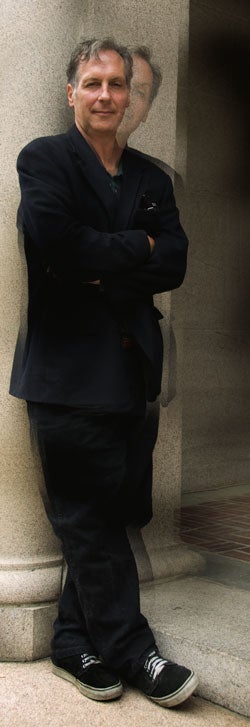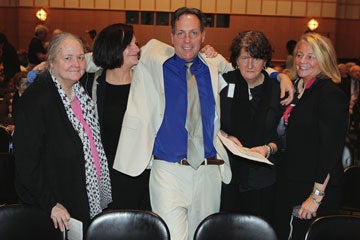Stalking Irish Madness
A memoir in which Patrick Tracey explores the roots of his family’s schizophrenia

The most important thing for disabled people,” says Patrick Tracey, “whether the disability is physical or mental is to be included, to be stood up for and claimed.”
So when the 1981 URI graduate won the prestigious L.L. Winship/PEN New England Award this past spring, he brought along all four of his sisters, including Michelle and Austine, whose schizophrenia was the subject of his book, Stalking Irish Madness: Searching for the Roots of My Family’s Schizophrenia.
Tracey’s story is one that’s almost defied telling. Within the space of two years, two of his beautiful sisters rapidly developed the severest form of mental illness. Then his mother died from the stress and sorrow of realizing she’d passed on a family blight.
The haunting yet uplifting memoir was chosen as one of the Best Books of 2008 by Slate magazine and was recognized by the National Alliance on Mental Illness with the KEN Award for making “an outstanding contribution to the understanding of mental illness.” Tracey’s memoir received national publicity, including write-ups in USA Today and a lengthy interview on NPR’s Talk of the Nation.
A Providence resident since the age of nine, when his family relocated from Boston, Tracey agonized over writing of his sisters who “dropped down the elevator shaft” of schizophrenia in early adulthood. He feared exposing their personal struggles but was compelled on a quest to find a cause for the illness that had plagued his family for generations. He grew up with a grandmother in an institution and an uncle on “the funny farm.” He ultimately found the answer in Ireland’s history of oppression and starvation at the hands of the British.

Tracey was an undergraduate at URI majoring in journalism and political science when first his older sister Michelle, and then a few year later Austine, had their breakdowns. “Austine even came to live with me. I spent weeks with her, trying to draw her out of her catatonic shell.” To no avail. She, like Michelle, eventually had to be hospitalized.
“The rapid onset that characterizes schizophrenia,” Tracey recalls, “the way it comes out of nowhere in the late teens and early twenties, was a gut-wrenching thing to witness—more like seeing my sisters sucked out in a tsunami than wrecked in a hurricane.”
The tragedies that befell his family filled Tracey with a despair that drove him away from his northeastern roots to pursue his journalism career first in Washington, D.C., and then in 2000, in London. It was there, in an East End pub, that he struck up a conversation with a British doctor who mentioned a genetic clue to the cause of schizophrenia in Ireland. The link was discovered in blood samples taken in County Roscommon—home of Tracey’s famine-starved ancestors. Though the information didn’t offer an immediate cure for his sisters, it fired his imagination.
In County Roscommon, from where the “twisted strand of DNA” originated, he found factors that caused madness to strike. In Irish folklore, the myth surrounding schizophrenia is that fairies “steal souls” and replace them with changelings.
Says Tracey, “The myth of madness goes back to the notion of the changeling. The schizophrenic was an impostor put in place of the sane person, whose being has been spirited away to the fairy otherworld. This notion of the otherworld is the perfect metaphor for schizophrenia. Its victims seem to be spirited away to another place altogether, a separate reality inhabited by disembodied voices.”
Tracey searched haunted caves and faerie mounds, historical records and healing springs. He questioned the reticent Irish, secretive and ashamed of the scourge that had disproportionately afflicted their population. Eventually, he spoke to doctors who’d discovered the gene link, dysbindin, that causes the disease, but sadly, offers no clues to a cure.
The gene mutation is the result of what Tracey calls his “three-legged stool” theory of Irish schizophrenia. Famine doubles (and can sometimes even triple) the risk of schizophrenia developing in children; older fathers also can triple it.
For centuries, famine was more or less a permanent condition in Ireland. Late age of paternity was due to the English squeezing the Irish off their land. Only the oldest Irish brother could marry when he inherited the right to lease “the pathetically small potato patch.” At this point he might be 50.
After meeting with the country’s foremost genetic researchers, Tracey returned home with a new mission—to tell the true history of a disease previously put down to drink and malfeasance, and to de-stigmatize the hereditary mental illness that’s plagued his family for five generations.
“Real tragedy may be the best training ground for a memoirist,” says Tracey. “Madness is a universal concern. It may be the deepest fear for all of us because, more than anything else, we are our minds. We Traceys are a family that has experienced first hand what few feel free to speak of. But I have no shame and believe, fundamentally, that we are only as sick as our secrets.
“Maybe the worst thing about this illness, worse than the altered reality and the hearing of voices itself, is the stigma attached.” The “crazy” label compounds the isolation, and the ill often respond with frustration and anger.
Since the book’s publication in August 2008, Tracey has been traveling up and down the East coast, holding readings for literary fans, and speaking to the mental health community and the public. Speaking at URI’s Ocean State Writing Conference in June, he moved the audience to tears and quickly sold out his supply of books.
The book’s continuing cascade of accolades has vindicated Tracey’s efforts. His two schizophrenic sisters are now stabilized and living in well-run group homes in the Boston area, near Tracey and his two other sisters.
Says Tracey, “The whole PEN ceremony was surreal. Not to overuse the adjective, but schizophrenia and the whole idea of hearing disembodied voices is pretty surreal too.”
For more information, see stalkingirishmadness.com
—By Christina Gombar ’82
Photos By Nora Lewis and Tom Fitzsimmons
 Home
Home Browse
Browse Close
Close Events
Events Maps
Maps Email
Email Brightspace
Brightspace eCampus
eCampus


